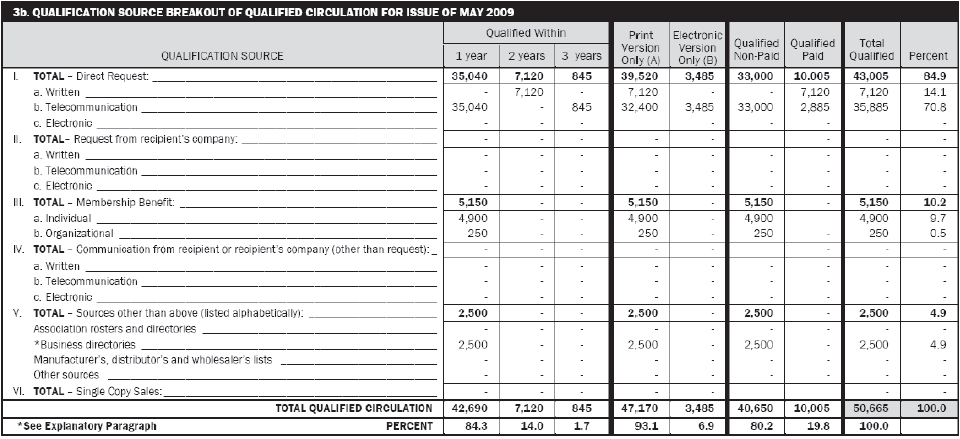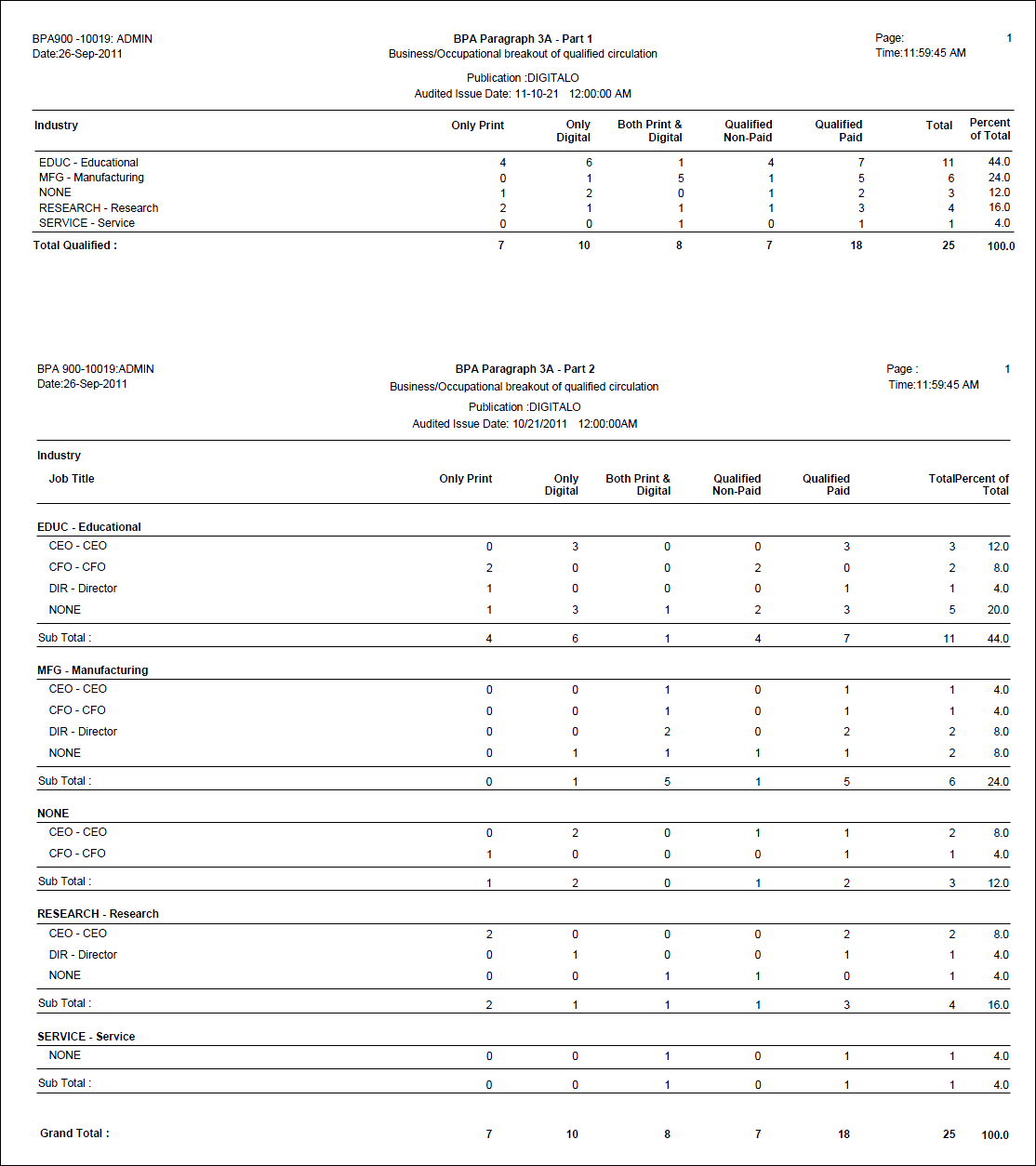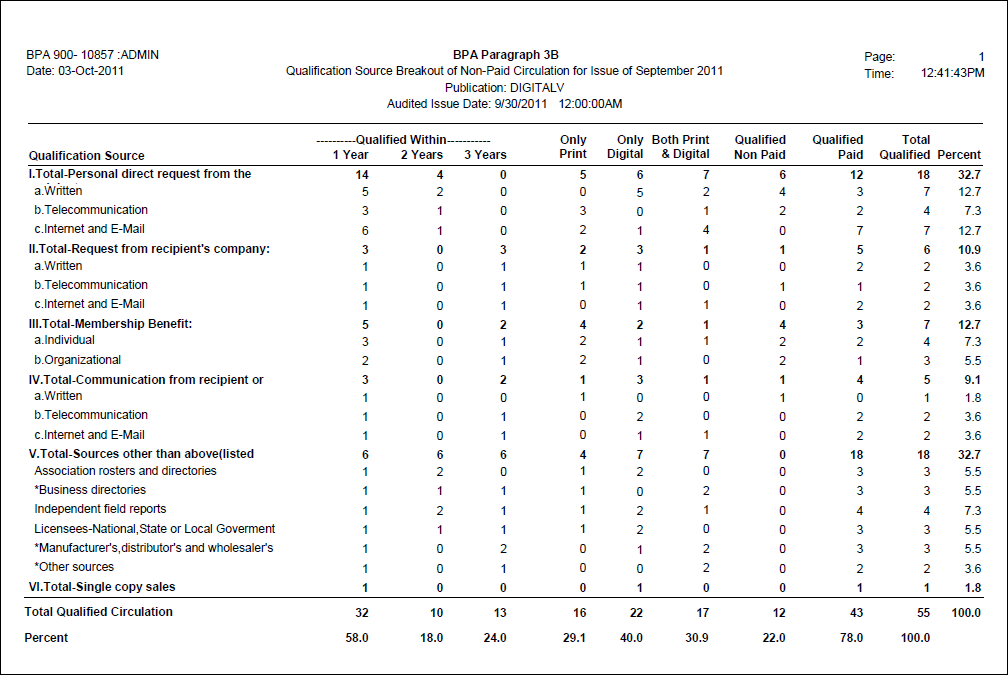 Information
on the NAICS can be found at www.naics.com.
Information
on the NAICS can be found at www.naics.com.The purpose of this section is to relay how closely the publication’s circulation matches the target market. This information covers one of the issues during the period covered by the statement. The statement indicates which issue is analyzed and whether it is typical by comparing it to the average circulation of the other issues reported on during the period.
Paragraph 3 is broken into three sections:
· 3a – Business/Occupational Breakout of Qualified Circulation for Issue
· 3b – Qualification Source Breakout for Non-Paid Circulation for Issue
· 3c – Mailing Address Breakout of Qualified Circulation for Issue
This paragraph indicates who is receiving the publication. The circulation must conform to both the Field Served and the Definition of Recipient Qualification. The type of data found in Paragraph 3a varies depending on the market. Some are simple and only include 3-4 classifications. Others have six or more North American Industrial Classification System (NAICS) breakouts.
 Information
on the NAICS can be found at www.naics.com.
Information
on the NAICS can be found at www.naics.com.

Counts by Business and Industry:
· Select all records from Sub_Audit_Stats where QUALIFICATION_CODE is
o QP - Qualified Paid
o QNP - Qualified Non Paid
· Group by Sub_Audit_Stats.INDUSTRY_CODE
Counts by Title:
· Select all records from Sub_Audit_Stats where QUALIFICATION_CODE is
o QP - Qualified Paid
o QNP - Qualified Non Paid
· First groups by Sub_Audit_Stats.JOB_FUNCTION_CODE, then by Sub_Audit_Stats.JOB_TITLE_CODE
 A
new audit type code of RI (Replacement Issue) has been added. We
do not select records where AUDIT_TYPE_CODE = ‘RI’.
A
new audit type code of RI (Replacement Issue) has been added. We
do not select records where AUDIT_TYPE_CODE = ‘RI’.
Publications reporting print and digital versions shall report such circulation in the following columns:
· Total Qualified Circulation
· % of Total Qualified Circulation
· Print Version Only
· Digital Version Only
· Both Print and Digital Versions (if applicable)
If applicable, the column “Both Print and Digital Versions” shall include each subscriber only once. The classifications for such subscribers shall be based upon the most recent qualification source for each piece of demographic information used to qualify subscribers of the print and digital versions.
Select Qualified only for counts in this report section:
· Counts for Print vs. Digital
o Counts for Print Version Only: Sub_Product.PRINT_VERSION_FLAG = ‘Y’ and Sub_Product.DIGITAL_VERSION_FLAG = ‘N’
o Counts for Digital Version Only: Sub_Product.PRINT_VERSION_FLAG = ‘N’ and Sub_Product.DIGITAL_VERSION_FLAG = ‘Y’
· Counts for both Print and Digital Version: Sub_Product.PRINT_VERSION_FLAG = ‘Y’ and Sub_Product.DIGITAL_VERSION_FLAG = ‘Y’
· Counts for Qualified Non-Paid vs. Qualified Paid
o Counts for Qualified Non-Paid
o Counts for Qualified Paid
The sum of Print Version Only + Digital Version Only + Print and Digital Version should = the sum of Qualified Non-Paid + Qualified Paid.
This paragraph indicates where the publisher obtained the qualified circulation (the source of the names) and the period in which the recipients were last qualified (the age of the names).
Publishers must provide an age analysis of the sources to show when the recipients were last qualified. The age and source of paid circulation can be reported at the publisher’s discretion.
The aging contains an analysis (count and percentage) of the qualified non-paid (and at the option of the publisher may contain an analysis of all qualified paid circulation) circulation by source using 1, 2, and 3-year columns. If, at the option of the publisher, paid circulation is reported and subscriptions sold for greater than three years have aged beyond three years, that circulation may be reported in the “three years” column with the change to “three+ years” as the column heading. Only paid circulation may be qualified for a period greater than 3 years.
Paid subscriptions older than 3 years may not report demographic information
in paragraph 3a, Business/Occupational analysis. All such subscriptions
shall be reported as “other paid circulation” in paragraph 3a.

Provides counts by qualification source and qualification method for Qualified Paid and Qualified Non-Paid subscriptions for the audited issue and then provides counts broken up by how recent is the qualification date of the subscription.
· Qualification source and qualification method are maintained in the Sub_Qual_Master table. Sub_Qual_Master logic has been updated so that if Order_Master.ORDER_METHOD_CODE is null, it will be updated to NONE.
· Qualification date will already have been determined in the creation of the Sub_Audit_Stats record and differs for membership versus non-membership related records.
· Paragraph 3b counts for qualified circulation for the audited issue need to be broken out by version type.
· First counts for total qualified circulation should be broken out by whether the subscription is for a print-version only publication, a digital-version only publication or a publication that the subscriber receives in both the print-version and the digital version. Then counts for total qualified circulation should be broken out by Qualified Non-Paid and Qualified Paid.
· The sum of Print Version Only + Digital Version Only + Print and Digital Version should = the sum of Qualfied Non-Paid + Qualified Paid.
Qualification date comes form Sub_Audit_Stats.qualification_date for the audited issue which was captured during fulfillment as either sub_qual_master.qualification_date or, for membership, from the last payment toward the related membership.
Qualification source is captured in the Sub_Audit_Stats.qualification_source. for the audited issue. This information is originally captured with the Sub_ Qual_Master information.
Qualification method is found in the Sub_Audit_Stats.QUALIFICATION_METHOD_CODE. This is captured originally in the Sub_Qual_Master table or set by default to Membership if the subscription is the result of a membership.
· Qualified-Paid: Sub_Audit_Stats.QUALIFICATION_CODE=’QP’
and
Sub_Audit_Stats.AUDIT_TYPE_CODE not in (‘SC’,’MC’,’RI’)
· Qualified-Non-Paid: Sub_Audit_Stats.QUALIFICATION_CODE=’QNP’
and
Sub_Audit_Stats.AUDIT_TYPE_CODE not in (‘SC’,’MC’,’RI’)
· Single
Copy Sales (Qualified Paid): Sub_Audit_Stats.qualification_code=’QP’
and
Sub_Audit_Stats.audit_type_code =“SC”
· Single
Copy Sales (Qualified Non-Paid): Sub_Audit_Stats.qualification_code=’QNP’
and
Sub_Audit_Stats.audit_type_code =“SC”
· Records are not selected where AUDIT_TYPE_CODE = ‘RI’.
This paragraph indicates how a publication is addressed to its recipients. All publications report this information in the same way allowing you to compare one publication’s method of addressing to another publication method.

As of 7.3.1 SP1, the “Individuals by name and title and/or function” also includes companies addressed by name and title and/or function.
Valid values for address analysis are:
· MC - Multi Copy
· SC - Single Copy
· NT - Name and Title
· NO - Name Only
· TO - Title Only
· CO - Company Only
Record Type |
Address Analysis Code |
Description for Address Analysis Code |
Logic |
|---|---|---|---|
Individual or Company |
MC |
Multi-Copy/Single Addressee |
Sub_Audit_Stats.AUDIT_TYPE_CODE = ‘MC’ |
Individual or Company |
SC |
Single-Copy Sale |
Sub_Audit_Stats.AUDIT_TYPE_CODE = ‘SC’ |
Individual |
NT |
Name and Title |
If Sub_Audit_Stats.ADDRESS_ANALYSIS_CODE not in (‘SC’,’MC’) and Sub_Audit_Stats.ADDRESS_ANALYSIS_CODE is null and Subscriber (order line ship-to customer) Customer.LABEL_NAME is not null and (Customer.PRIMARY_JOB_TITLE or Cus_Audit_Default.JOB_FUNCTION_CODE or Cus_Audit_Default.JOB_TITLE_CODE is not null) and Order_Qty = 1 |
Individual |
NO |
Name Only |
If Sub_Audit_Stats. ADDRESS_ANALYSIS_CODE not in (‘SC’,’MC’) and Sub_Audit_Stats.ADDRESS_ANALYSIS_CODE is null and Subscriber (order line ship-to customer) Customer.LABEL_NAME is not null and (Customer.PRIMARY_JOB_TITLE and Cus_Audit_Default.JOB_FUNCTION_CODE and Cus_Audit_Default.JOB_TITLE_CODE are all null) and Order_Qty = 1 |
Company |
NT |
Name and Title |
If Sub_Audit_Stats.AUDIT_TYPE_CODE not in (‘SC’,’MC’) and Sub_Audit_Stats.ADDRESS_ANALYSIS_CODE is null and Subscriber address (order line ship-to address) Cus_Address_Detail.ATTENTION_LINE is not null and (Cus_Audit_Default.JOB_FUNCTION_CODE is not null or Cus_Audit_Default.JOB_TITLE_CODE is not null or Cus_Address_Detail.JOB_TITLE is not null) and Order_Qty = 1 |
Company |
NO |
Name Only |
If Sub_Audit_Stats.AUDIT_TYPE_CODE not in (‘SC’,’MC’) and Sub_Audit_Stats.ADDRESS_ANALYSIS_CODE is null and Subscriber address (order line ship-to address) Cus_Address_Detail.ATTENTION_LINE is not null and (Cus_Audit_Default.JOB_FUNCTION_CODE and Customer.JOB_TITLE_CODE and Cus_Address_Detail.JOB_TITLE are all null) |
Company |
TO |
Title Only |
If Sub_Audit_Stats.AUDIT_TYPE_CODE not in (‘SC’,’MC’) and Sub_Audit_Stats.ADDRESS_ANALYSIS_CODE is null and Subscriber address (order line ship-to address) Cus_Address_Detail.ATTENTION_LINE is null and either Cus_Audit_Default.JOB_FUNCTION_CODE is not null or Cus_Audit_Default.JOB_TITLE_CODE is not null or Cus_Address_Detail.JOB_TITLE is not null) and Order_Qty = 1 |
Company |
CO |
Company Name Only |
If Sub_Audit_Stats.AUDIT_TYPE_CODE not in (‘SC’,’MC’) and Sub_Audit_Stats.ADDRESS_ANALYSIS_CODE is null and Subscriber address (order line ship-to address) Cus_Address_Detail.ATTENTION_LINE is null and Cus_Audit_Default.JOB_FUNCTION_CODE is null and Cus_Audit_Default.JOB_TITLE_CODE is null and Cus_Address_Detail.JOB_TITLE is null and Order_Qty = 1 |
First counts for total qualified circulation should be broken out by whether the subscription is for a print-version only publication, a digital-version only publication, or a publication that the subscriber receives in both the print-version and the digital version.
· Then counts for total qualified circulation should be broken out by Qualified Non-Paid and Qualified Paid.
· The sum of Print Version Only + Digital Version Only + Print and Digital Version should = the sum of Qualified Non-Paid + Qualified Paid.


